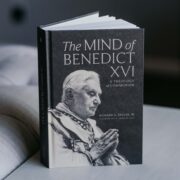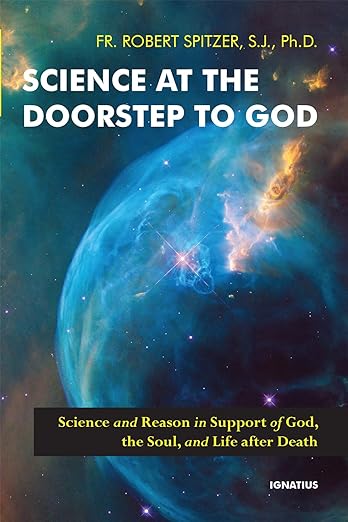Among people who drift away from religion, many claim science has disproved God. However, author Fr. Robert Spitzer believes just the opposite is true. In his new book, Science at the Doorstep to God, he claims that today there is more science-based evidence for God, the soul, and life after death than ever before.
The book synthesizes eight recent studies confirming an intelligent creator of physical reality as well as a transphysical soul capable of surviving bodily death, resulting in the most comprehensive scientific treatment of God and the afterlife to date, combining natural scientific method, metaphysical method, medical studies, anthropological and genetics studies, and phenomenological descriptions.
Word on Fire’s Senior Publishing Director, Brandon Vogt, recently connected with Fr. Spitzer to discuss these findings and why science should not lead people away from God, but rather toward him.
Brandon: Thanks for joining us! Many thinkers follow Stephen Jay Gould’s concept of non-overlapping magisteria (NOMA), which holds that science and religion are two distinct domains that don’t coincide. Science covers the empirical universe while religion covers questions of moral meaning and ethical value. Yet your book argues that science and religion are much closer than we might think, and even more, that science points to God. How is this so?
Fr. Spitzer: Though science and faith have two distinct methods aiming at two distinct purposes, Gould’s generalization that the two domains do not coincide is inaccurate in several respects. Regarding distinct methods and purposes, the purpose of science is to give as complete an explanation as possible of the physical universe and its constituents. Science’s method begins with observational data, proceeds to the formulation of falsifiable hypotheses, and uses measurable relationships among data to verify or falsify those hypotheses. The purpose of faith/revelation is, in the words of Pope Pius XII, to give sacred truths needed for salvation. Its method begins with revealed truths in Scripture and Tradition, and uses exegetical, historical, and literary criticism to assess the meaning and truth of specific claims. These scholarly conclusions are then validated by the Church magisterium.
Gould’s generalization overlooks several major areas in which science can point to transphysical/supernatural reality. Three of the most prominent are:
1. Physics/Cosmology can show the likelihood of finitude in universal space-time (implying a beginning of physical reality) from several distinct data sets. Such a beginning implies a causative power outside of physical reality.
2. If a beginning of physical reality is likely, then physics/cosmology can also show the likelihood of a transcendent intelligence needed to explain the exceedingly, exceedingly high improbability of the fine-tuning of initial conditions and constants needed for any lifeform to develop in our universe.
3. Peer-reviewed medical studies of near-death experiences, terminal lucidity, and intelligence in hydrocephalic patients imply a credible possibility, if not a likelihood, of consciousness outside of the physical brain/body as well as survival of that consciousness after clinical death (flat EEG, fixed and dilated pupils, no gag reflex, etc.).
Science at the Doorstep to God discusses the contemporary studies of these three phenomena in detail. There are other philosophical, linguistic, and anthropological studies that correlate with and corroborate the above three scientific areas.
You begin the book by targeting the age-old assumption that most scientists reject God. You note that according to the latest surveys, “a supermajority of young scientists and physicians believe in God or a higher spiritual power.” Why are younger scientists increasingly drawn to God?
There are several reasons why young scientists have increasingly moved to belief in God or a higher transcendent power:
First, among young physicists, there is considerable awareness of the need for something like transcendent intelligence to explain the exceedingly improbable occurrence of the finely-tuned initial conditions and constants needed for the development of life.
Second, few young scientists believe in the materialistic/physicalistic explanation of our universe. Quantum physics, the correlation of physical laws, and other non-reductionistic evidence strongly imply that a “mindlike” dimension of the universe is more fundamental than strictly physical processes and structures. When this is combined with the evidence of fine-tuning for life (mentioned above) and the astounding mathematical intelligibility of our universe (from the most microscopic to the most macroscopic levels), this mindlike ground of our universe appears to be intelligent.
Third, among young physicians and neuroscientists, the awareness of evidence for a transphysical ground of consciousness, which can exist outside the body and survive clinical death, is widely known (see, for example, the 2022 New York Academy of Sciences Annals, which recognize this).
Science can provide considerable evidence for an intelligent creator, a transphysical soul, and life after death.
Fourth, many young scientists have distanced themselves from old prejudices against religion, coming from incomplete or exaggerated accounts of the Galileo affair and early challenges of religion to science. It is generally well-known that in the case of the Catholic Church, well over 150 Catholic clergy were involved in the development of all areas of science, including Nicolaus Copernicus (the first to mathematically justify heliocentrism), Roger Bacon (one of the earliest formulators of scientific methodology), Fr. Georges Lemaître (the first to mathematically justify the Big Bang theory, which is the most comprehensive physical explanation of universal origins), Fr. Gregor Mendel (the father of quantitative genetics), and Bishop Nicolas Steno (the father of contemporary stratigraphy/geology). See the Wikipedia list of Catholic clergy scientists for more.
Fifth, contemporary evidence showing the compatibility and complementarity of science and faith has opened the way for many religious students to study science. This has not only freed them from having to hide their religious beliefs among colleagues, but also to find probative scientific evidence corroborating their beliefs.
In the book, you explore two lines of argument for a transcendent creator of the universe, one based on the Big Bang and another on the fine-tuning of various conditions that allow our universe to exist. In your experience, which of these two approaches do you find most effective in convincing atheists that the universe was designed?
The second approach—the fine-tuning of universal constants and initial conditions—is the most inescapable and convincing. In view of the high unlikelihood of eternal inflation and an infinite multiverse (see for example, Stephen Hawking, Thomas Hertog, Thomas Banks, and many other esteemed physicists), the occurrence of extremely low entropy at the Big Bang and the exceedingly fine-tuned cosmological constant needed for the development of life in our spacious universe screams out for an explanation. The odds against our low entropy occurring at the Big Bang is the same as a monkey typing the entire corpus of Shakespeare perfectly by random tapping of the keys in a single try, and the odds of our cosmological constant having a value that will permit life is fine-tuned to one part in a trillion, trillion, trillion, trillion, trillion, trillion, trillion, trillion, trillion, trillion. These are but two among many other examples of fine-tuning for life (see Science at the Doorstep to God, Chapter 2).

Beyond the values of initial conditions and constants at the Big Bang, many biologists, geneticists, and biochemists are confounded not only by the development of the DNA molecule and its related constituents within the cell, but also the exceedingly, exceedingly complex programming on the genome—particularly the human genome—which could not have occurred even at the most rapid natural rates possible in four billion years (the age of life on the earth). This is recognized not only by theistic scientists (such as Dr. Francis Collins, Director of the Human Genome Project, in The Language of God), but also by self-proclaimed skeptics, such as Thomas Nagel (in his book, Mind and Cosmos: Why the Materialistic Neo-Darwinian Conception of Nature Is Almost Certainly False).
Some of the most interesting parts of the book cover examples of near-death experiences, which suggest that the soul continues to exist beyond bodily death. Can you share one or two of the most powerful examples?
I’ll cover two points—(1) the veridical evidence of consciousness surviving clinical death (exemplified in the case of Bradley Burroughs) and (2) the example of Linda Stewart, who (like many patients) experienced a heavenly domain during her near-death experience.
The veridical evidence of consciousness surviving clinical death includes hundreds of cases in which patients left their bodies, went outside the operating room (and even outside the hospital), and gave perfectly accurate descriptions of what was happening during the time of their clinical death (flat EEG, fixed and dilated pupils, indicating a virtual absence of electrical activity in their physical brains). Furthermore, eighty percent of blind people were able to see (most of them for the first time) when they were clinically dead. These blind patients were also able to perfectly describe what they saw not only in the operating room, but outside the operating room and hospital.
For example, Bradley Burroughs, a sixteen-year-old boy blind from birth, reported that his soul-body left his physical body and went outside the hospital and up on the roof. From there, he saw for the first time snow on the ground, tram tracks grooved into that snow, and a grove of trees in the distance. As he was observing the scene, a tram, having a large sign on the back with an arrow pointing to the right, passed by the hospital, moved up the tracks, and went to the right into the grove of trees. The schedule of the tram showed that it passed by the hospital at the precise moment when Bradley was clinically dead. Aside from the virtual impossibility of explaining this by guesswork or hallucination, we are further perplexed by how someone without any visual images in his physical brain could accurately hallucinate such a scene. There are hundreds of verified cases of such accurate reporting by both sighted and unsighted people. This evidence is further validated by reports of meeting deceased relatives, who reported historical facts (later corroborated) hitherto unknown by these patients (see University of Virginia Medical School documentation).
An interesting case of the “soul-body” proceeding to an “other worldly” domain is Linda Stewart. This is a partial report of what she experienced in her own words:
[As I left my pain-racked physical body and was swept upward], I knew I was in the arms of a being who cherished me with perfect love and carried me from the dark void into a new reality. . . . With the eyes of my soul body, I looked to see what held me in such love, and I beheld a radiant, Spirit being so magnificent and full of love that I knew I would never again feel the sense of loss. . . . The radiant Spirit was Christ, the manifestation and expression of pure love.
Science at the Doorstep to God (chapter 4) describes these phenomena, the multiple peer-reviewed medical studies concerning them, and the inadequacy of physicalist explanations to account for them.
It’s common today for people to reduce human consciousness to mere physical processes in the brain. Why should we think that our minds are more than mere brain matter?
In addition to the peer-reviewed medical studies of near death experiences (described in the previous answer), there are five indications that consciousness is not reducible to the physical brain:
1. Peer-reviewed medical research into terminal lucidity. This refers to a phenomenon where patients who have severely debilitating conditions of their physical brains (rendering them incapable of thought, memory, and verbal production) suddenly manifest a high degree of intelligence about one to two hours before death. These patients talk about their impending deaths, emotional states, religious experiences, tasks they need to do before dying, etc. Since their physical brains cannot explain these activities, it implies a transphysical source of consciousness and thought.
2. Intelligence in hydrocephalic patients. In a study by John Lorber of 600 hydrocephalic patients, five percent of patients with over ninety-five percent of their brain replaced by spinal fluid in the cranium (hydrocephalus) were measured to have a significant IQ (over 100), and some of these had a genius level IQ, including one man with an IQ of 143, who had virtually no brain. This again points to a transphysical origin of consciousness and intelligence.
3. Human conceptual ideas and syntax are non-linear and abstractly formulated and interrelated. This means that “the minimal meaning-bearing elements of human languages” are seemingly irreducible to physical processes and structures alone (see Berwick and Chomsky, Why Only Us? MIT Press, 2017, p. 90). This explains why a chimpanzee, who can learn 150 words in American Sign Language referring to perceptions, cannot pass a minimal syntax test, such as differentiating “dog bites man” from “man bites dog.” What is this transphysical component of abstract thought and language? Is it the “soul” evident in near-death experiences and terminal lucidity?
4. There are significant reasons for believing that human self-consciousness (which can be in two relative positions with respect to itself simultaneously) cannot be described by physical processes and structures alone. This again implies a transphysical source of self-consciousness.
5. The human capacity to transcend Gödel’s incompleteness theorems in the development of mathematics. This, too, shows that human intelligence transcends mere physical processes and structures.
All five of these indications of transphysical consciousness and intelligence are explained in Science at the Doorstep to God, chapters 4 and 5.
In addition to scientific and philosophical arguments for God, you also turn to human experience, seeking an explanation for human conscience, our desires for truth, love, and justice, and our innate sense of free will. Let’s focus on that last one. Determinism is on the rise today, positing that everything we do or believe is determined by outside factors. Why do you instead believe we humans have free will, and how does this point to God?
Determinism (the negation of free will) is the natural conclusion of physicalism—the reduction of reality to physical processes and structures alone. If we are merely the result of these physical structures, then we will be determined by the physical laws governing them. This results in our being mere stimulus-response machines.
Since the time of the quantum revolution, this physicalist-deterministic view of the human person has been challenged because quantum theory shows indeterminacy within physical systems. But the challenge to determinism does not stop there.
The considerable evidence of a transphysical soul (see questions #4 & #5 above) shows that the human person transcends mere physical processes and structures not only in self-consciousness and abstract thought, but also in its very nature (i.e., its capacity to exist outside of a physical body/brain and physical processes and structures themselves).

Moreover, human beings have an awareness of a sacred-spiritual-transcendent presence within themselves and the world (Science at the Doorstep to God, chapter 6, section I) and at least a tacit awareness of perfect truth, love, goodness/justice, beauty, and home (chapter 6, section III). When these two kinds of transcendental awareness are combined with the contents of conscience—a general awareness of the good and the divine obligation to do it and avoid evil (chapter 6, section II)—we see the ground of our freedom. The above transcendental powers and awareness enable us to break out of the stimulus-response determinations of physical processes and laws. Our self-consciousness gives us an “inner universe” independent of the outer world, and our abstract cognition and language enables us to ask questions and contemplate correct answers about and beyond the physical world. Furthermore, our awareness of moral obligation and the will of the sacred transcendent reality enables us to ask the central question of human freedom: “Should I act according to my conscience and awareness of the will of the sacred transcendent reality—or should I act according to sensorial pleasure, ego advantage, and my desire to dominate?” Though we may not ask the question in precisely this form, the above transcendental powers and awareness lead us to this transcendent-moral question. The answer, within certain limits (chapter 6, section IV), constitutes the ground of our freedom.
In the end, how far can science go in revealing who God is and what he’s like? What can science not tell us about God?
Science can provide considerable evidence for an intelligent creator, a transphysical soul, and life after death. When it is complemented by philosophical reasoning, it can go deeper and wider on these issues. Though science (and philosophy) can tell us much about the existence and “what of God and the soul,” it cannot tell us about the “who” of God. Does this intelligent creator love us; redeem our suffering; get involved in our lives; and inspire, protect, and guide us? Is the afterlife eternal? Do our actions in this life—for good or evil—determine what the afterlife will be like for us?
Though we can know something of God’s goodness and love from our inner spiritual-transcendent awareness (chapter 6, section I) and have a general sense of his moral will from our conscience, there are simply hundreds of questions that these natural ways of knowing the transcendent leave unanswered.
At the end of the day, we can only get answers to these questions if God reveals himself to us. This revelation about God’s heart and will is found in sacred texts. For Christians, the New and Old Testaments along with Church Tradition are the founts of revelation, whose definitive interpretation is given by the Church instituted by Jesus in his commission of St. Peter.
In brief, science (and philosophy) can show us much about the existence and “what” of God, and Sacred Scripture and Tradition (as interpreted by the Church) can give us much about the “who” of God as well as his moral will. Science can tell us much about the “how” and “what” of nature, while Sacred Scripture and Tradition can give us much about the “why” of nature.

